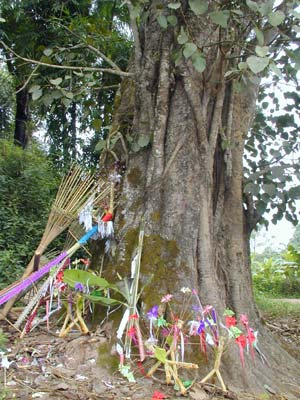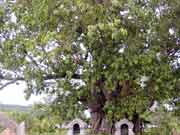 |
|
Holy Trees of the Dai Folks (Sacred
Fig Ficus religiosa) |
Sacred Figs are the most frequently seen trees in the Dai and Bulang communities of Xishuangbanna. According to the investigation of the experts, there were no such trees in the rain forests of Xishuangbanna originally and they were introduced to this part together with Buddhism. In ancient times, Jinghong and Xishuangbanna were called "Cheli" in the ancient Chinese documents, and they might be the Dai name for Sacred Figs. That's to say, the authors of the ancient books once came to this land, when they asked the local folks the name of the place, the local folks told them so. For the time being, Jinghong still has a Sacred Fig of over 400 years, which is as tall as 35 meters with a thickness of 2 meters. It's said that the tree was planted by a Dai chief and a chief of Menghai together as a symbol of friendship.
 |
|
Holy Tree of the Dai Folks |
The story goes that: the founder of Buddhism, Sakyamuni, in order to avoid bitterness of the samsara of birth, aging, illness and death, He gives up the chance to inherit the kingship; He goes here and there in an attempt to find the real meaning for life; finally, He distills himself under a Sacred Fig and He wins over entices of all evil spirits, and comes to understand the real meaning of life and becomes the Buddha. So, in all the Buddhist scriptures, we could find that, the Sacred Figs are deemed as "trees of Buddhism". This is also described in the frescoes in many temples. In nearby countries where the local folks believe in Hinayana, such as the Laos, Burma and Thailand, we could see Buddhist statures in distillation in all forms. According to the Buddhist documents, Buddhism has altogether 28 generations of masters; and each master would rule the world for 5000 years; correspondingly, each master has a tree to indicate the process He becomes the Buddha. Based on this theory, the researchers of the Tropical Botanical Garden of Xishuangbanna carried out a careful investigation into the 28 varieties of trees; and they transplanted all the "trees of Buddha" in the general temple in Xishuangbanna, the national plant garden and the temple in Man'e Village. All the Buddhist trees including Sacred Fig are worshipped by the believers. Besides the yards of the temples, these trees are also planted in the villages, yards and nearby places. The local folks believe it is a good deed for them to plant Buddhist trees; they believe they would be blessed by planting such trees and could win happiness in their next life. Since the believers treat the Buddhist trees as the embodiment of Buddhas, they regard activities such as cutting the Buddhist trees as a serious crime. In the ancient laws of the Dai folks, it is stipulated that: "those who fell Buddhist trees, their children would be sent to temples as slaves". There are also descriptions about Buddhist trees in all artistic works. For example, hairyfruit musella
(Musella lasiocarpa),is a story widely told. Hairyfruit musella is the embodiment of the 7th Fairy. When She speaks, Her mouth is full of golden lotus; and She is the embodiment of charm and kindness. Hairyfruit musella is the symbol of the holy, the noble and the auspicious. In the love songs of the Dai folks, the young girls like to describe young men as hairyfruit musella. On the day of their wedding ceremony, they believe it is a day when the "Hairyfruit Musella goes to Heaven".


|